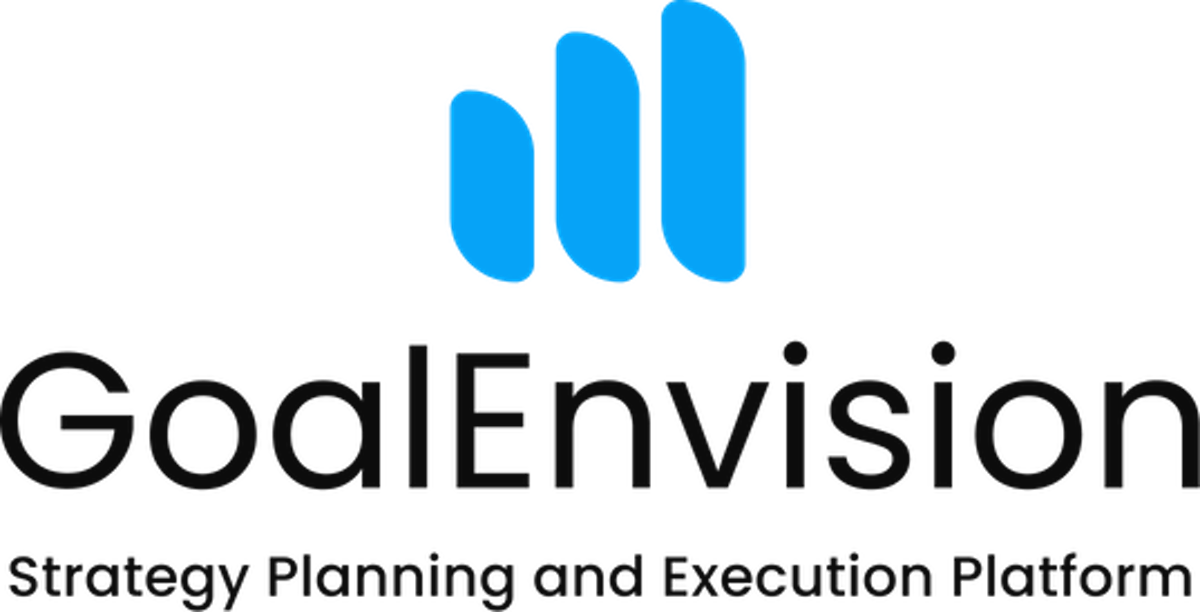What does a strategic plan look like?
Share this article
Creating a strategic plan is critical to a company's success and long-term growth. A well-thought-out strategic plan helps leaders and management teams define clear objectives, allocate resources effectively and stay focused on the company's overall vision. In this article, we review the key components of a strategic plan, from vision and mission to follow-up and alignment, and show how you can use tools such as GoalEnvision to ensure your strategy leads to real results.
Introduction to strategic planning
Having a clear strategic plan is critical to the company's success. A strategic plan acts as a map that guides the company towards its long-term goals. For leaders and management teams, it is important to understand what is included in a strategic plan and how to effectively implement it.
Vision and mission statement: The basis for a strategic plan
A strong strategic plan starts with a clear vision and mission statement. The vision describes the company's long-term goals and ambitions, while the business concept clarifies what the company does and how it creates value for its customers. These elements provide direction and inspiration for the entire organization. For example, a vision could be "To become the market leader in sustainable energy solutions", and the mission statement could be "We deliver innovative solar energy systems that reduce our customers' energy costs and environmental impact."
Formulate growth targets
Growth targets are specific and measurable goals that the company wants to achieve in order to grow. These targets can be to increase turnover, expand into new markets or improve customer satisfaction. For example, a growth target might be "Increase company revenue by 15% within two years."
Define strategic goals
Strategic goals are concrete actions and initiatives that help the company achieve its growth goals. These goals are broken down into specific projects and activities that different departments and teams are responsible for. For example, a strategic goal could be "Launch three new products within the next year" or "Reduce production costs by 10% by implementing lean methods."
Identify and create conditions
In order to succeed with the strategic goals, the company must identify and create the right conditions. These can be divided into three main categories:
-
Structure: Necessary resources and support such as equipment, efficient procedures and financial investments. Example: "Install a new ERP system to improve inventory management and production efficiency."
-
Ability: Knowledge, skills and experience required to perform the work. Example: "Implement a training effort for the sales team to increase skills in digital sales."
-
Energy: Drive, motivation and commitment of the employees. Example: "Implement a reward system to increase employee engagement and motivation."

Each condition is linked directly to specific strategic objectives to ensure that the right resources and support are in place to achieve these objectives. For example, if a strategic goal is to "increase customer satisfaction by 20%," condition might include "Hire additional customer service staff," "Implement a new CRM system," and "Conduct regular customer surveys."
The five perspectives
An effective strategic plan should include a broad analysis of different perspectives within the company. GoalEnvision uses five success perspectives to ensure a holistic approach:
-
The market perspective: Focus on understanding and satisfying customers' needs. Example: "Conduct market research to identify new customer segments."
-
The sales perspective: Focus on communicating and selling the company's offers. Example: "Develop a new digital marketing strategy to increase online sales."
-
The operations perspective: Focus on improving internal processes for efficiency. Example: "Implement lean methods to reduce waste in production."
-
The people perspective: Focus on staff competence and motivation. Example: "Develop a comprehensive training program to increase the skills of employees."
-
The finance perspective: Focus on financial results and returns. Example: "Reduce operational costs by 5% through more efficient use of resources."
Resource allocation and division of responsibilities
An effective strategic plan requires clear resource allocation and division of responsibilities. This means determining what resources are needed for each goal and who is responsible for achieving them. Example: "The marketing department is responsible for developing the new digital marketing strategy and reports weekly on the progress."
Implementation of strategic initiatives
Implementation is the most critical part of a strategic plan. This is where the plans are translated into practical measures. The company must ensure that all activities are followed up regularly and that any obstacles are quickly identified and addressed. Continuous communication and collaboration is the key to successful implementation. Example: "Conduct monthly reconciliation meetings to ensure projects are progressing according to plan."
Follow-up and evaluation of goals
To ensure that the company is on the right track towards its goals, it is important to regularly follow up and evaluate progress. This is done by measuring results against established indicators and by using tools such as reports and surveys. Regular monitoring helps identify areas that need improvement and adjustment. Example: "Use customer satisfaction surveys each quarter to measure progress toward the goal of increasing customer satisfaction by 20%."
Adjustment and adaptation of the strategy
Strategic plans are not static documents. They must be adjusted and adapted based on changes in the market, customer needs and the company's own performance. By being flexible and responsive, the company can quickly adapt its strategy to handle new challenges and opportunities. Example: "Reassess and adjust marketing strategy every six months based on market research feedback."
Tools and methods for effective strategic planning
To facilitate strategic planning and implementation, there are several tools and methods that can be used. GoalEnvision is an example of a digital tool that helps companies plan, implement and follow up on their goals in a structured and clear way. The tool enables clear communication, simple follow-up and efficient resource allocation. Example: "Use GoalEnvision to create a common platform where all strategic goals and progress can be tracked in real time."
By following these steps, companies can create a robust strategic plan that not only defines their goals, but also provides a clear path to achieving them. A well-thought-out and implemented strategic plan is a key factor for long-term success and sustainable growth.
Share this article
Did you like this article? Here is more...
Latest




